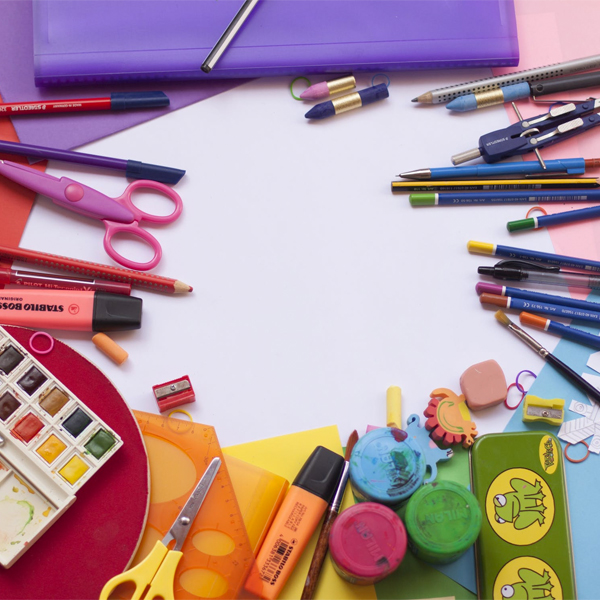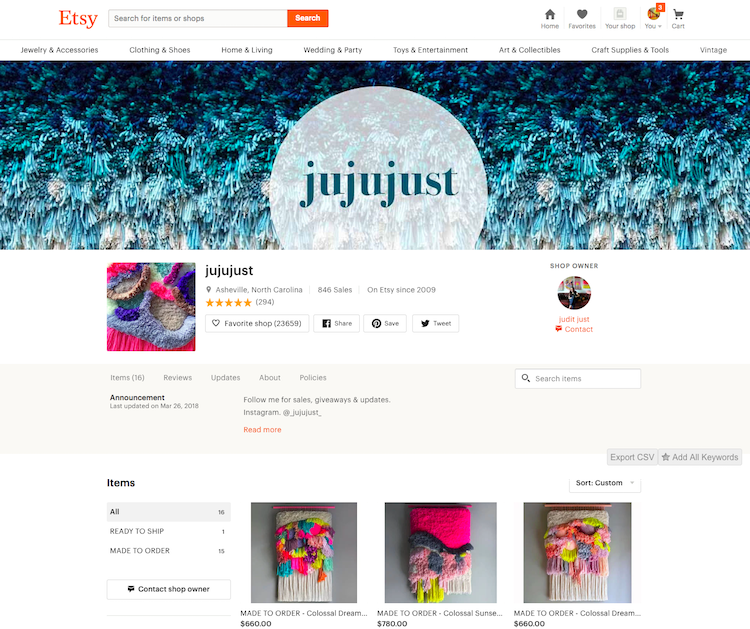
Photo: jujujust on Etsy
This post may contain affiliate links. If you make a purchase, My Modern Met may earn an affiliate commission. Please read our disclosure for more info.
A platform like Etsy can be a great way to get your feet wet when it comes to selling your art online. Since launching in 2005, they’ve helped millions of artists and makers easily bring their products to market. And for many, their easy-to-use interface is the perfect way to see if their side hustle has what it takes to transform into a full-time career.
Sellers are charged a $0.20 listing fee for each item in their shop, plus PayPal fees if you accept this type of payment. What you get in return is a place on an established platform that has a large community and forums that can help you grow. You can also track analytics in your shop to see what people are most interested in and you can list as many items as you’d like.
But, as with any platform, there are also negatives. With so many sellers, it can be difficult to make your work stand out from the crowd and get noticed. It takes hard work and good marketing skills to make sure your shop is optimized in order to bring your items into the search results of your customers.
Ultimately, if used well, Etsy can be a perfect launching pad for your career and is an easy and convenient place for customers to find your work. It may even bring in bigger clients. For instance, many of the items in the My Modern Met Store were found thanks to their Etsy presence.
We spoke with three successful Etsy entrepreneurs to get their take on how to take advantage of what the platform offers. Australia-based Shovava is run by Roza Khamitova, whose artistic scarves are wearable pieces of art. Jujujust by textile artist Judit Just is home to her incredible contemporary wall hangings, which allow the Spanish artist to express her creativity from her new home in North Carolina. Kirikí Press, which sells DIY embroidery kits and patterns, is the brainchild of Michelle Galletta, who started the indie design company when she couldn’t find a good pattern to make an embroidered doll for her niece.
Items by Shovava and Kirikí Press are also available via the My Modern Met Store after their work was discovered on Etsy. Let’s look at what they all had to say about what they’ve learned during their time on Etsy and the secrets to making the platform work in your favor.
Etsy is a great platform for artists and makers to sell their creations. Here's how to make it work for you.
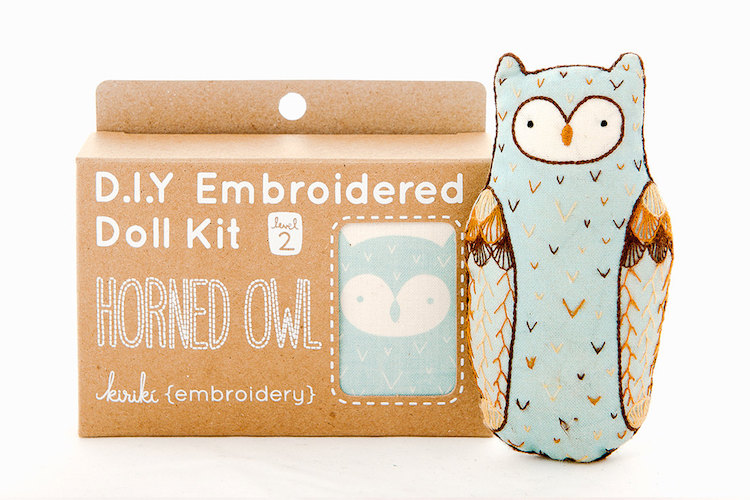
Kirikí Press is known for their embroidery dolls for all levels of crafters. Several models are also available at the My Modern Met Store. (Horned Owl Embroidery Kit | $18.00)
Make an Original Product
Before rushing to put items into a store, think carefully about your products and make sure they are cohesive. For Galletta of Kirikí Press, she found herself in a unique niche with her embroidered dolls. This made for slow going at the beginning, but now she’s found herself at the top of a good market for herself. In the sea of items on Etsy, being unique is key.
“Start with a cohesive line of products, even if you don't have enough to fill a whole page,” she tells My Modern Met. “When I first got the idea for my business my brain was pumping out a million ideas a minute and I was all over the place, from embroidery to jewelry to paper crafts. I wrote down all of the ideas, but then paired them down to what became my first product line of 7 doll kit designs. It's tempting to throw a bunch of unrelated stuff together to make your shop look more full, but a cohesive product line is more impressive.”
For Just, originality was also key—both from a marketing and creative perspective. She tells us: “I’ve found that if you really want your business to succeed, it's really important to be unique. Try to offer a very specific kind of product. Do not copy. Study your competition and do the opposite. Be original and believe in your work, no matter what. Build your community. Ultimately, just keep working and creating. Keeping my hands busy is what helps me the most to keep my mind clear and focused.”

Shovava has expanded their popular scarf line into kimonos, swimwear, t-shirts, and skirts. (Floral Kimono | $89.00)
Use High-Quality Photos
Once you have your products down, you’ll want to show them off in the best light possible—this means taking good photographs. After all, you don’t want your hard work to go to waste with poorly lit photos that don’t show off the quality of your goods.
Roza Khamitova of Shovava has found that quality photographs are one key to success. “Given that you have an original product to sell, great photos are an absolute must—especially the first one, that's the photo that will ultimately make someone click on your shop. Photos are the only way for people to see and judge your product online.”
Some of her top tips?
- “Use all 10 images available to you per listing.”
- “Try organizing your backgrounds with similar color palettes and/or lighting. Keeping all of your photos consistent can make your shop look cohesive and give an overall sense of your brand.”
- “Use natural light, it will help show the true color of your item as well as provide a warmth to your photos. Try setting up your photoshoot area outside or near a window. “
- “Always use close-up shots as well as others further back. Close-ups can show off the texture. A shot from farther away can show the item's size and how it looks in context.”
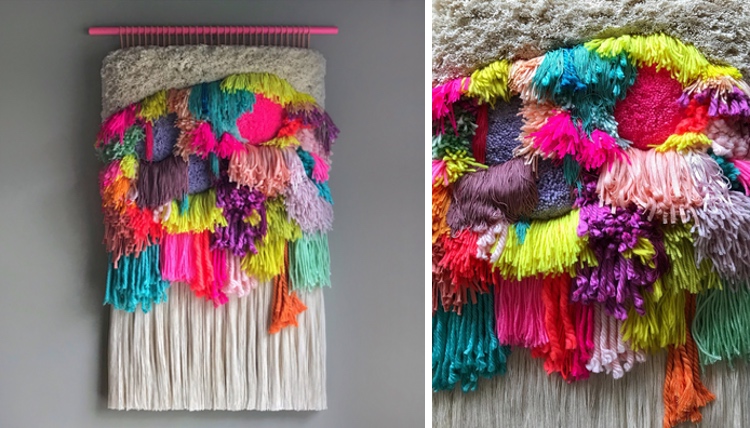
jujujust is known for its colorful, contemporary textile art, which is made to order. (Colossal Dreamland N.3 | $660.00)
Get Into a Routine
Keep yourself in a good work rhythm by setting a routine when it comes to your store. This will keep you organized and allow you to have focused work time for marketing, customer service, shipping, and creating.
After several years of getting her shop up and running, Just is settling into a routine that allows for a better work-life balance. Ultimately, this also allows her to put more positive energy into her creations. “I try to keep an agenda and schedule my orders there on a weekly basis. This helps with the stress of owning my own business. It's also a good reminder to enjoy my work as much as I can, and to make each piece special and with lots of love.”
She's also discovered how important it is to schedule in downtime. “Since my studio is my home, it's really hard to disconnect. But it's so necessary to focus on something else once in a while. I stretch, dance, go for a walk, lay down in the sun or play the piano to have some little breaks. Getting a dog helped me out a lot, too. I like to keep a consistent daily schedule and try to have my weekends free.”
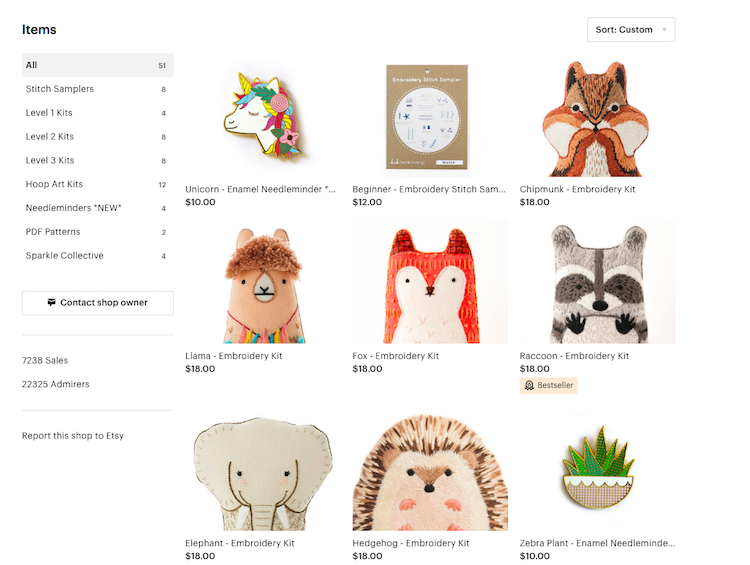
Kirikí Press
Focus on Customer Service
Spend the extra time to engage with your customers and stay on top of orders and questions. Good reviews will help bring in more orders, as buyers typically will look more favorably on shops with a lot of positive comments. Remember, being a good business owner is more than creating beautiful products, it's also about creating a positive customer experience from start to finish.
“Customer service can also be as important as anything else on the production chain, plus the little details make a big difference,” shares Just. “Be sure to reply quickly and follow up, if you can. Even though it can be overwhelming sometimes, I try to follow up with some orders to see if my clients have received their tapestries (and that they like them). I sometimes send process shots, too. Knowing exactly what your clients like, and doing it again and again, will help you grow your business.”
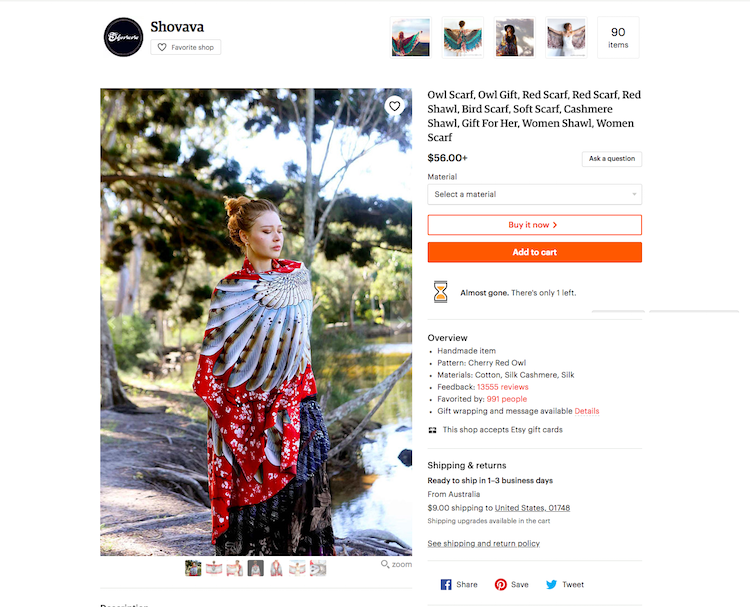
Shovava
Protect Your Product
It can be an exciting time when your work takes off, but in the digital age you'll also want to protect your intellectual property. This is something that Khamitova learned the hard way, when she began to notice that her designs were being stolen.
“When I found out that my designs (and even identity!) were blatantly stolen I was really heartbroken for a while,” the Shovava owner shares. “I believe copying someone's hard work is worse than stealing. An artist puts his whole heart and soul into a piece, it is a product of his whole life, a lifetime of work, developing skills and intuition to create this piece. And someone steals it in a matter of hours all just to make a quick profit. So don't believe it when people say ‘Imitation is the biggest form of flattery.' ”
“The first thing anyone should do after completing a design or artwork is to register your intellectual property. It's not expensive and a pretty straight-forward process. It has been a truly big learning curve for me! We have been very successful at taking legal action against infringers and now I can say that the amount of counterfeits has significantly gone down.”
Leverage Social Media
In terms of marketing, social media has been a tool widely used by all three entrepreneurs. Instagram, in particular, is a great way to build a community and show your products to a wider audience. Over 100,000 followers tune in to see the colorful textile art that Just creates, as well as get insight into her creative process. Galletta, who has also successfully grown her Instagram following, used a measured approach that started with craft fairs.
“My first couple years in business I did as many local craft fairs as possible,” Galletta shares. “I also did giveaways with international bloggers to get my name out there. Now that I'm a bit more established, Instagram has been amazing! Follow and interact with people whose work you genuinely like and use hashtags so new people can find you.”
In our Ultimate Guide to Branding, you'll learn everything you need to know about creating a cohesive and memorable brand presence, from refining product packaging to customizing your shop home. https://t.co/Hi6gfuMuOy 📸 kealohajewelry pic.twitter.com/MeZnTflv9e
— Etsy Success (@EtsySuccess) July 17, 2018
Take Advantage of Etsy's Support
One of the great things about using an established platform like Etsy is that they provide plenty of resources for their sellers. It's up to you to take advantage of them. Unsure about branding and marketing? There's an entire section in Etsy's Seller Handbook to help you out. Khamitova also recommends following Etsy Success, which gives tips and tricks on how to better your store. Lastly, don't forget to engage with the online community, it's there to help. “Don't be afraid to talk to other sellers,” Khamitova recommends. “I found everyone to be very generous and helpful.”
Shovava: Website | Etsy | Facebook | Instagram
Jujujust: Etsy | Instagram
Kirikí Press: Website | Etsy | Facebook | Instagram
Related Articles:
15 of the Best Etsy Shops for Creative Products From Makers Around the World
7 Steps to Successfully Start a Freelance Career


































































